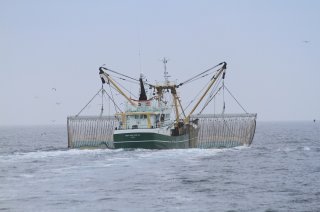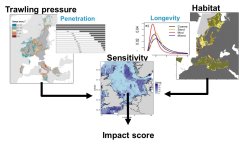
News
Assessing the impact of fisheries on the seabed
In Europe different types of fisheries exist that impact the seafloor. To quantify their impact, BENTHIS developed an impact assessment framework that requires data on the distribution and intensity of trawl fisheries, on habitat distribution and on species sensitivity to fishing.
The BENTHIS impact assessment methodology for trawling impact is generic and can be applied to any region and bottom contacting fishing gear. This framework is applicable to all benthic habitats and trawl fisheries and can be applied from small to large spatial scales (local, regional, management areas). The framework is specifically suitable for EU member states that need to report on the impact of their fisheries on the marine ecosystem in 2018 under the Marine Strategy Framework Direction (MSFD).

First maps of fisheries intensity need to be made. For this, VMS-data (Vessel Monitoring System) are used. Different fishing gears have a different physical impact on the seafloor, depending on the mass, size, and speed of the fishing gear elements. The physical impact of a fishing gear is quantified for individual gear elements such as otter boards, twin trawl clump, ground rope, and sweeps that herd the fish. The impact per fishing gear is the sum of the impact of the individual elements.
Second, habitat maps are needed, since the physical impact will differ between e.g. coarse sandy seafloors compared to muddy areas. Such maps have been compiled in various other projects and can be obtained from European data portals.
The third type of information requires monitoring data on benthic species, and information on their vulnerability to each type of fishing gears. In the BENTHIS project, databases of species traits have been made for a few areas. The vulnerability of benthic species to fisheries will depend on their vertical position in the sediment, and their morphology. The recovery rate of benthic species will depend on traits like the longevity, maturation age, reproductive characteristics and way of dispersal.
In the North Sea, results show that the Sublittoral mud (EUNIS A5.3) is affected the most due to the combined effect of intensive fishing and large proportions of long-lived taxa.
- Unfortunately, your cookie settings do not allow videos to be displayed. - check your settings
Source:
Rijnsdorp, A.D., Bastardie, F. Bolam, S.G., Buhl-Mortensen L., Eigaard O.R., Hamon K.G., Hiddink J.G. Hintzen N.T., Ivanovic A., Kenny A., Laffargue P., Nielsen R.N., O’Neill F.G., Piet G.J., Polet H., Sala A. , Smith C. , van Denderen, P.D. , van Kooten T., Zengin M.A., 2016. Towards a framework for the quantitative assessment of trawling impacts on the sea bed and benthic ecosystem. ICES Journal of Marine Science.
